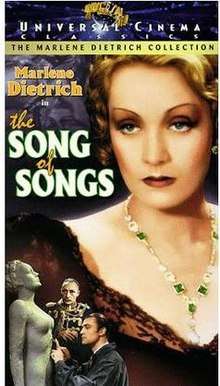The Song of Songs (1933 film)
The Song of Songs is a 1933 American Pre-Code romantic drama film starring Marlene Dietrich as a naive German peasant named Lily who moves to Berlin and suffers from a considerable amount of heartache. This particular version of the film was based on the 1908 novel by Hermann Sudermann, Das Hohe Lied. The novel's title, which translates to English as "The High Song," does indeed refer to the Song of Solomon, which is often described in German as "Das Hohe Lied der Liebe." However, that is not the only possible inference. "HoheLied" has been translated as "ode" "hosannas" "praises" and used in purely secular as well as religious contexts.[1] Most telling in this case is the use in German of the entire phrase to describe the "great song of love" or "ode to love" in Paul's First Epistle to the Corinthians. This creates a double layer of meaning to the title of the novel in German, one that could not be duplicated in an English rendition.
| The Song of Songs | |
|---|---|
 | |
| Directed by | Rouben Mamoulian |
| Written by | Hermann Sudermann (novel) Edward Sheldon (play) Leo Birinsky Samuel Hoffenstein Rouben Mamoulian (uncredited) |
| Starring | Marlene Dietrich Brian Aherne Lionel Atwill |
| Distributed by | Paramount Pictures Universal Pictures (Current) |
Release date |
|
Running time | 90 minutes |
| Country | United States |
| Language | English |
The 1914 play, The Song of Songs by Edward Sheldon also contributed to this version. It is a remake of the 1918 silent film The Song of Songs starring Elsie Ferguson and the 1924 silent film Lily of the Dust with Pola Negri.[2]
Cast (in credits order)
| Character | Actor |
|---|---|
| Lily Czepanek | Marlene Dietrich |
| Richard Waldow | Brian Aherne |
| Baron von Merzbach | Lionel Atwill |
| Mrs. Rasmussen | Alison Skipworth |
| Walter Von Prell | Hardie Albright |
| Fräulein Von Schwertfege | Helen Freeman |
Summary
Once in Berlin, Lily meets and poses for Richard, the sculptor who lives across the street. Despite the eventual romance between the two lovers, Lily marries one of Richard's wealthy clients, Baron von Merzbach. By the end of the story, Lily and Richard are reunited after Lily struggles on a personal journey.[3]
Reviews and criticism
The Encyclopædia Britannica notes that the film was "dismissed by a number of critics as 'a trite melodrama'.[4] However, it is difficult to either verify the proportion of negative to positive reviews or to substantiate the disdain the professional critic community might have held for the film due to lack of preservation of the actual reviews.
Box office
The film was a box office disappointment for Paramount.[5]
References
- "Linguee". Linguee.
- The American Film Institute Catalog Feature Films: 1931–40 by The American Film Institute, c. 1993
- "The Song of Songs (1933)". NYMag.com. Retrieved 2016-02-04.
- "The Song of Songs | film by Mamoulian [1933]". Encyclopædia Britannica. Retrieved 2016-02-04.
- D. W. (Nov 25, 1934). "TAKING A LOOK AT THE RECORD". New York Times. ProQuest 101193306.